November 10, 2023
This blog post examines the City of Chicago’s long-term liabilities. It includes a review of trends in the City’s long-term governmental and business-type activities, liabilities, debt service trends and a discussion of its tax-supported long-term debt and recent credit rating changes.
More information about Chicago’s current long-term debt burden can be found in the Civic Federation’s FY2024 City of Chicago budget analysis.
Long-term liabilities include all of the obligations owed by a government over time. Significant increases in long-term liabilities over time can be a sign of fiscal stress. Between FY2018 and FY2022, the last year for which audited financial information is available, the City of Chicago’s total long-term liabilities increased by 18.5%, or $7.3 billion, rising from $39.5 billion to $46.8 billion. Much of this increase was because of a $1.1 billion increase in net other post-employment (OPEB) liabilities and a $5.0 billion increase in net pension liabilities.
Types of Chicago Long-Term Liabilities
Long-term City of Chicago liabilities include:
- Bonds, Notes and Certificates Payable: These are amounts reported for different types of tax supported long-term debt, including general obligation, lease, tax increment financing and revenue debt.
- Net Pension Liabilities: Chicago reports 100% of the net pension liabilities of its pension fund in the Statement of Net Position to comply with GASB Statement No. 68 requirements.
- Net Other Post Employment Benefit (OPEB) Liabilities: Non-pension benefits provided to employees after employment ends are referred to as Other Post-Employment Benefits (OPEB). OPEB includes health insurance coverage for retirees and their families, dental insurance, life insurance and long-term care coverage. It does not include termination benefits such as accrued sick leave and vacation.
- Claims and Judgments: Claims and judgments are amounts needed to finance future liabilities arising from personnel, property, pollution and casualty claims.
- Pollution Remediation: The City’s pollution remediation obligations are primarily related to Brownfield redevelopment projects, including removal of underground storage tanks, cleanup of contaminated soil and removal of other environmental pollution identified at the individual sites.
Chicago Long Term Liability Trends
The table below presents the City’s total long-term liabilities, including long-term debt from bonds and other liabilities in the Governmental Funds for the five-year period from FY2018 to FY2022 from audited annual financial reports; FY2022 is the most recent year available. These liabilities are primarily paid for with taxes, such as property taxes and other broad-based taxes like the sales tax.
The five-year increase in total long-term liabilities between FY2018 and FY2022 was 18.5%. This was a nearly $7.3 billion increase from $39.5 billion to $46.8 billion. Total long-term debt alone rose by 6.3%, or $697.0 million, from nearly $11.0 billion to $11.7 billion.
Other liabilities, which include net pension obligations, net other post-employment obligations, lease obligations, pollution remediation liabilities and claims and judgments increased between FY2018 and FY2022 by 21.6%, or $6.2 billion between FY2018 and FY2022. Much of the increase was because of a $1.1 billion increase in net OPEB (other post-employment benefits) liabilities and a $5.0 billion increase in net pension liabilities. The increase in net pension liabilities was due to employer contributions short of the needs of the funds, changes to the expected rate of return on investment and investment losses over the five-year period.
All long-term liabilities increased by 3.2%, or $1.5 billion, in the one-year period between FY2021 and FY2022, rising from $45.4 billion to $46.8 billion. Total long-term debt, which includes bonds, notes and certificates payable, rose slightly by 0.8%, or $92.5 million, during this two-year period, from $11.6 billion to $11.7 billion.
Total other liabilities between FY2021 and FY2022 rose by $1.4 billion, or 4.4%, increasing from $33.2 billion to $34.7 billion. That increase was primarily attributable to a $1.6 billion, or 5.3%, increase in net pension liabilities.
As of FY2021, GASB 87 requires operating leases for property, plants or equipment to be shown as liabilities on balance sheets. They are considered a liability because they represent an obligation to make future payments. The City reported $522.7 million in lease liabilities in FY2021, which decreased to $444.3 million in FY2022.

In addition to long-term liabilities in the Governmental Funds, the City of Chicago also has incurred long-term liabilities for its business-type activities. These include revenue bonds issued to support infrastructure projects within the City’s four enterprise funds (Water, Sewer, O’Hare and Midway Airports) and pension obligations incurred in those funds. These obligations are primarily paid for with user fees and charges.
Between FY2018 and FY2022, the total amount of business-type long-term liabilities increased slightly by 1.1% or $230.0 million, rising from $20.8 billion to $21.0 billion. In this period revenue debt fell by 1.7% or $288.7 million. However, net pension liabilities rose by 9.7% or $323.9 million, increasing from $3.4 billion to $3.7 billion. Lease liabilities were $194.8 million in FY2022, falling from $243.2 million the prior year.
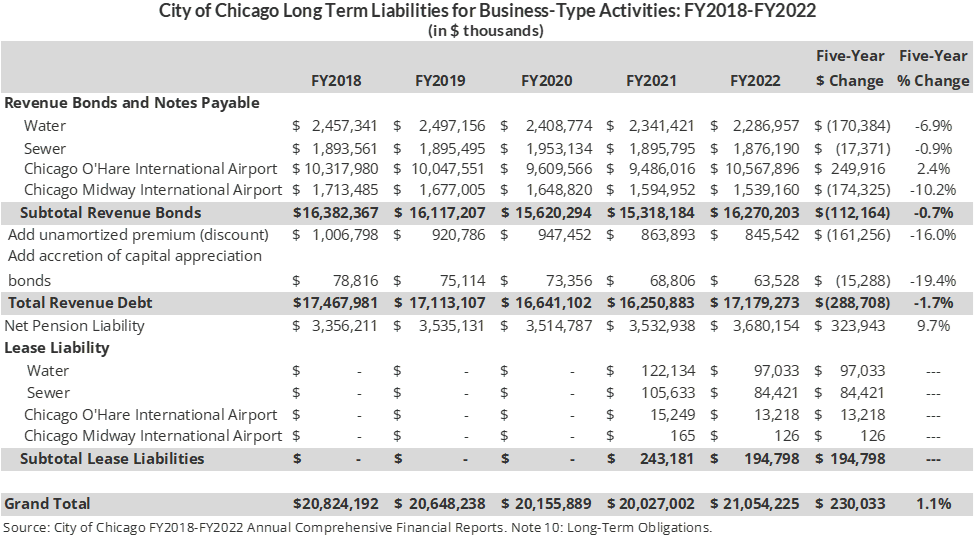
The following chart shows the total amount of Chicago long-term liabilities for both governmental activities and business-type activities. Between FY2018 and FY2022, these obligations rose by nearly $7.5 billion or 12.5%, increasing from $60.3 billion to $67.8 billion.
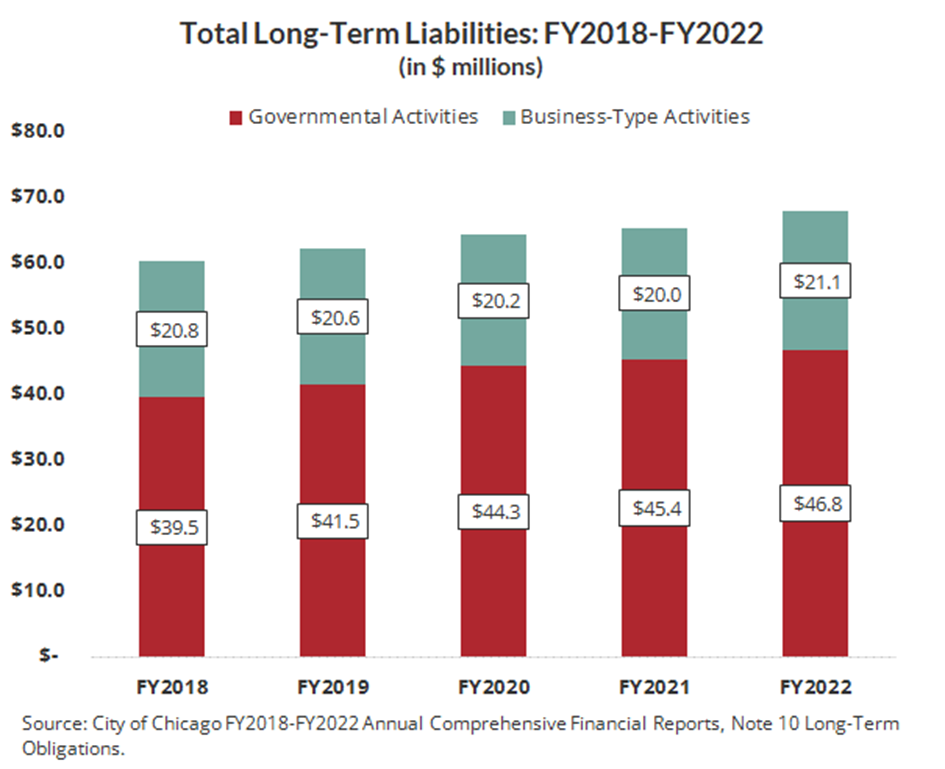
Long-Term Direct Debt Trends
Direct debt is a government’s tax-supported debt. Increases over time should be monitored as a potential sign of rising financial risk. The exhibit below presents ten-year trend information for the total amount of City of Chicago net direct debt. During that time, total net direct debt decreased by 18.6%, or nearly $1.4 billion. This represents a decrease from $7.7 billion in FY2013 to nearly $6.2 billion ten years later. While direct debt has generally decreased over the ten-year period examined, this is partially due to the shifting of some debt to the Sales Tax Securitization Corporation established in 2017.
Long-term direct debt between FY2013 and FY2017 rose to $9.6 billion, before dropping by 35.0% or $3.3 billion by FY2022. The large $1.5 billion decrease between FY2017 and FY2018 was due to the refunding of certain callable general obligation bonds by the Sales Tax Securitization Corporation (STSC Series 2018AB and Series 2018C refunding bonds) which shifted direct debt obligations to the Sales Tax Securitization Corporation. The decline between FY2019 and FY2020 was also due to the issuance of additional STSC debt in order to refund general obligation bonds. Further refinancing of STSC debt in FY2021 and FY2022 contributed to additional reductions in debt service costs. While the decline in direct debt over this time period is a positive indicator, the City’s overall debt burden remains high.

A common ratio used by rating agencies and other public finance analysts to evaluate long-term debt trends is direct debt per capita. This ratio reflects the premise that the entire population of a jurisdiction benefits from infrastructure improvements.
In the ten years between FY2013 and FY2022, direct debt per capita declined by 20.0% from $2,845 to $2,275. The significant decrease between FY2017 and FY2018 is attributed to the refunding of certain callable general obligation bonds by the Sales Tax Securitization Corporation.
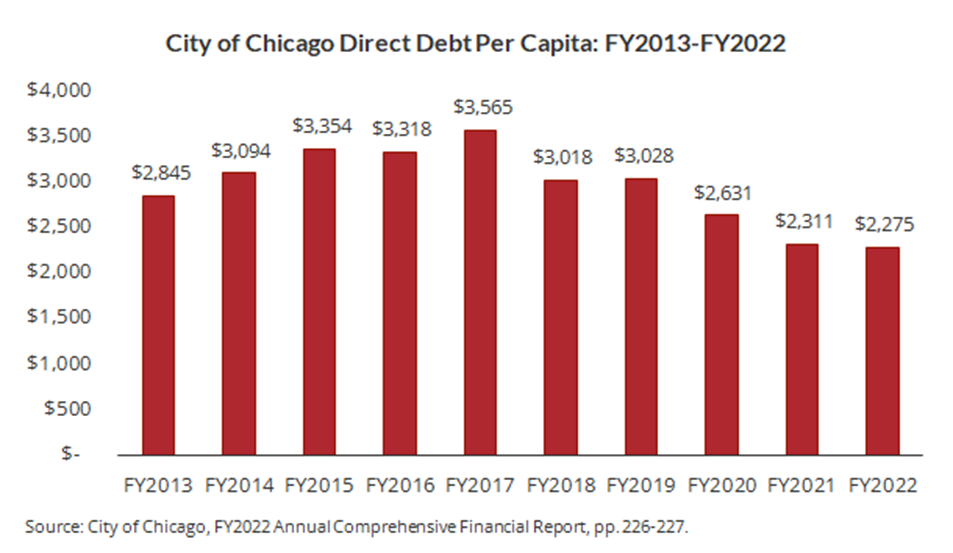
Overlapping Debt: Chicago vs. Other Governments
Chicago taxpayers pay for the debt of not only the City of Chicago, but also other governments that overlap Chicago’s borders. The next exhibit compares total City of Chicago net direct debt with overlapping net debt reported by seven other major Cook County governments with boundaries coterminous with the City of Chicago or located partially within its boundaries. These governments are Chicago Public Schools, Cook County, the Forest Preserve District of Cook County, the Metropolitan Water Reclamation District, the Chicago Park District, City Colleges of Chicago, and the Chicago School Building Improvement Fund. Rating agencies and other financial analysts commonly monitor overlapping debt trends as an affordability indicator when governments consider debt issuance.
Chicago’s portion of total overlapping long-term debt in FY2022 accounted for 30.0% of all long-term debt. Between FY2013 and FY2022, combined direct debt from other overlapping governments increased by 40.7% at the same time City of Chicago debt fell by 21.3%. Total direct debt from all eight major governments including Chicago rose by 13.8% or $2.5 billion. The rate of increase in direct debt issued by the other overlapping governments far outpaced the increase for Chicago. These figures do not account for additional City of Chicago debt issued through the Sales Tax Securitization Corporation.
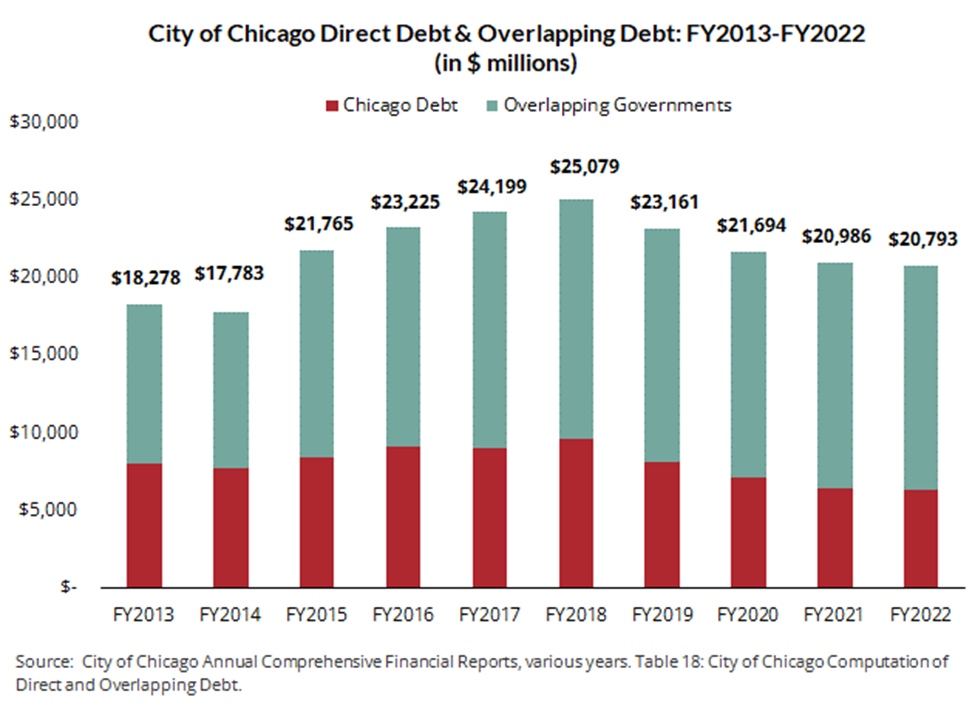
Chicago Debt Service
The City of Chicago budgets annual debt service to pay the principal and interest on outstanding debt. The City’s FY2024 proposed budget anticipates debt service expenditures of $2.1 billion.
The ratio of debt service expenditures as a percentage of total expenditures is frequently used by rating agencies to assess governmental debt burden. Debt service payments at or exceeding 15-20% of all appropriations are considered high by the rating agencies. Chicago’s FY2024 debt service appropriations of $2.1 billion represent 17.0% of total net appropriations of $12.2 billion within the City’s local funds (local funds include the operating funds, special revenue funds, debt funds, pension funds and enterprise funds, but exclude grant funds). The City will appropriate $492.3 million in general obligation debt service alone in FY2024.
Since FY2020, debt service appropriations have risen by 7.5%, while total net appropriations have increased by 23.9%. The debt service ratio has averaged 20.0% over the five-year period analyzed. Thus, Chicago’s debt service ratio is high, reflecting the City’s large debt burden.
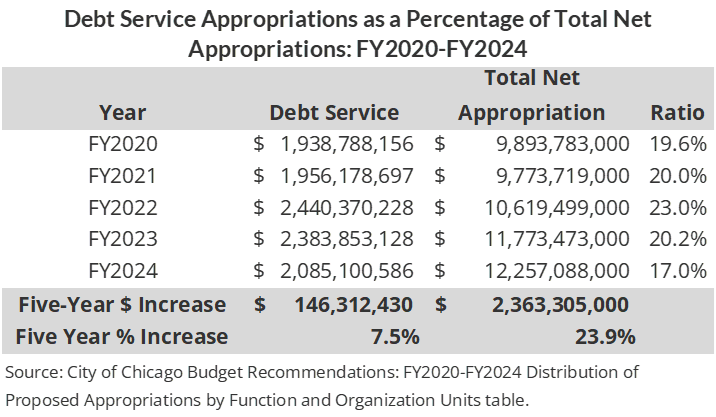
Recent Bond Issues
A summary of the most recent City of Chicago bond issues is presented below:
- The City issued $513.5 million in Midway Airport senior lien revenue refunding bonds in late October 2023.
- The Chicago Sales Tax Securitization Corporation issued $219.1 million in revenue bonds in September 2023. This included a $176.8 million second lien refunding issue and a $42.2 million refunding issue.
- The Sales Tax Securitization Corporation issued $740.5 million in bonds in January 2023. Of this total amount, $159.9 million were two issues of social bonds, $217.1 million were two refunding bond issues and $363.5 million were taxable refunding bonds.
- In August 2023, Chicago issued $171.8 million in Chicago O’Hare Airport Customer Facility Charge Senior Lien Refunding bonds.
- In May 2023, the City issued $576.4 million in water revenue bonds. Of that amount, $254.2 million were second lien water revenue project bonds and $322.2 million were refunding bonds. As of this date the City has no outstanding senior lien bonds
- The City also issued $452.6 million in second lien wastewater revenue bonds in May 2023. This issue included $260.1 million in wastewater revenue transmission bonds and $192.5 million in refunding bonds.
- The City issued $523.8 million in general obligation bonds in December 2022 to finance projects in the Chicago Works program and Chicago recovery plan.
City of Chicago Bond Ratings
The table below summarizes the credit ratings as of November 2023 for various types of City bonds.
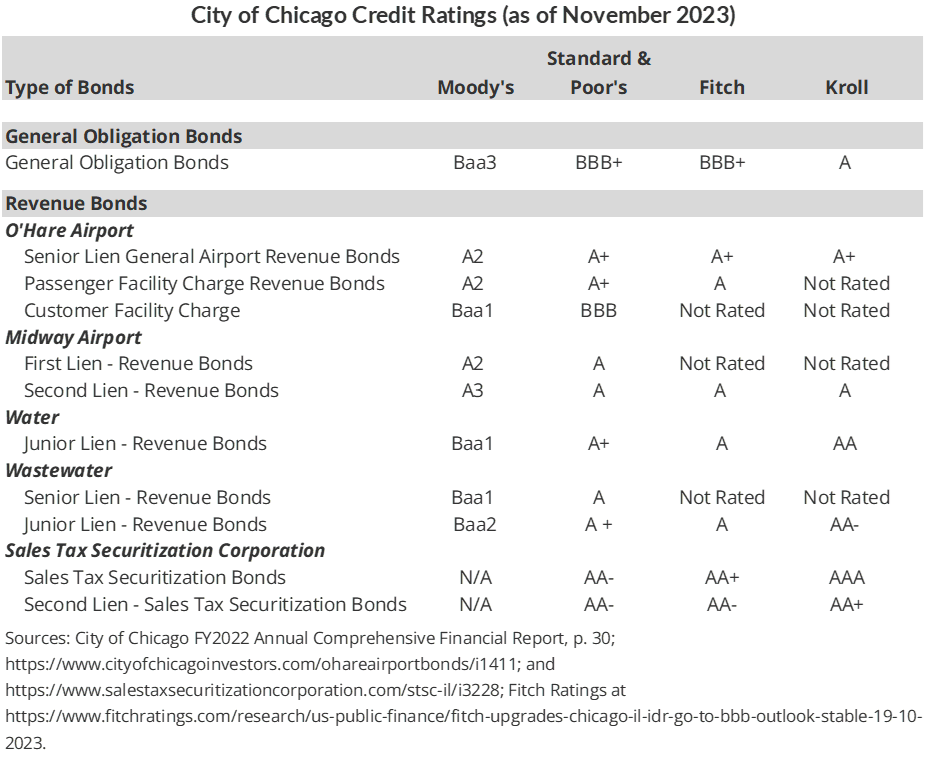
Ratings Changes in 2022 and 2023
The City of Chicago has received several upgrades from credit rating agencies over the past year, for both the City’s long-term general obligation debt and other debt. City debt primarily consists of general obligation debt secured by a full faith and credit pledge of revenues, revenue debt secured by earmarked taxes and fees, Sales Tax Securitization Corporation (STSC) debt, and tax increment financing debt paid for by taxes on incremental value increases of property values in TIF districts. The recent rating upgrades were primarily due to the City’s improved economic and revenue conditions as it emerged from the depths of the COVID-19 pandemic. The upgrades also reflect the City’s efforts to reduce liabilities by making additional payments for its pension funds.
Several of the rating upgrades were the first in well over a decade. The last time Fitch had upgraded the City’s general obligation debt was over 25 years ago.
The credit rating increases are significant not only because they signal improved financial stability, but also because they save the City money over time. According to the City, every credit rating upgrade represents $100 million in interest cost savings on each $1 billion in bonds issued.
The following are brief summaries of credit upgrades from Fitch, Standard and Poor’s, Moody’s and Kroll for Chicago’s long-term general obligation and revenue debt in 2022 and 2023, to date.
Fitch Ratings Changes
On October 19, 2023, Fitch Ratings upgraded City of Chicago general obligation debt to BBB+ from BBB with a stable outlook and its Sales Tax Securitization Corporation sales tax bonds to AA+ from AA with a stable outlook. The rating for second lien STSC sales tax bonds was affirmed at AA-. The upgrades were based on reductions in the amount of Chicago’s long-term liabilities, growth in the City’s economic resource base and improved debt management practices.
On November 4, 2022, Fitch Ratings upgraded the City’s $1.5 billion in outstanding second lien sewer revenue bonds one notch to A from A- with a positive outlook. The rating agency based its decision on an assessment that the system’s operating costs were low, it had moderate life cycle needs and the sewer system’s finances were stable. On the same day, Fitch also upgraded the City’s $1.8 billion in outstanding second lien water revenue bonds one notch to A from A- with a positive outlook. Fitch found that Chicago’s water system provided an essential service with very low operating costs and moderate life cycle needs, and that it possessed a strong financial profile.
On October 21, 2022, Fitch Ratings upgraded the City of Chicago’s general obligation bonds to BBB from BBB-. This was Fitch’s first upgrade of Chicago general obligation bonds in 25 years due to the City’s improved financial condition, rather than a change in the rating agency’s methodology. Fitch also upgraded Chicago Sales Tax Securitization Corporation's bonds to AA from AA-. Both issues received a positive outlook. The reason for the upgrade was the City’s commitment to improving its pension funding, maintaining strong reserves and implementing structural budget measures that have improved its ability to respond to future cyclical economic changes.
In August 2022, Fitch Ratings upgraded the rating on $8.5 billion in outstanding general revenue airport bonds to A+ from A. The credit upgrade was based on O’Hare Airport’s improved financial performance and stable debt service coverage levels as well as progress that had been made on the airport’s expansion and improvement plans.
Standard & Poor’s Ratings Changes
In April 2023, S&P upgraded City of Chicago water second lien revenue bonds and sewer second lien revenue bonds. Both issuances were raised one notch to A+ from A. The rating agency cited as reasons for the upgrade the City’s improved financial situation as well as its transition to using the American Water Works Association’s cost-of-service rate methodology for suburban customers rather than a uniform rate structure.
S&P upgraded Chicago Midway Airport revenue bonds to A from A- with a stable outlook in February 2023. The upgrade reflected S&P’s assessment that activity at Midway Airport had recovered to a large extent from the effects of the COVID 19 pandemic and their expectation that the airport would continue to have stable and adequate financial performance.
On November 10, 2022, Standard and Poor’s affirmed Chicago's general obligation bond rating of BBB+ and revised the rating outlook from Stable to Positive. The outlook change was based on S&P’s evaluation that the City had significantly improved its financial stability in recent years, including its commitment to increase pension funding.
In August 2022, S&P raised its rating for Chicago’s outstanding senior lien general O’Hare International Airport revenue bonds to A+ from A. It also increased the rating on O’Hare’s outstanding standalone passenger facility charge revenue bonds to A+ from A. The upgrades were based on increased passenger traffic and improved enterprise operations (S & P Global Ratings summary on Chicago O’Hare International Airport, August 18, 2022).
In June 2022, S&P revised the outlook to positive from stable for Chicago’s customer facility senior lien Series 2013 bonds and affirmed its BBB long term and underlying ratings for these bonds. The action was based on improved rental car activity as the City recovered from the COVID-19 pandemic (S & P Global Ratings, Chicago O’Hare International Airport Bond Rating Outlook Revised to Positive on Improved Rental Car Activity, June 11, 2022.).
S&P revised the outlook from stable to positive in January 2022 for the City of Chicago’s first lien and second lien general airport revenue bonds issued for Midway International Airport. At the same time, it affirmed its A- rating on these bonds. The outlook change was based on the improved economic situation at Midway Airport as air traffic activity reached 87% of September 2019 levels (S & P Global Ratings, Chicago Midway International Airport Bond Rating Outlook Revised to Positive from Stable on Improving Enplanements, January 20, 2022).
Moody’s Ratings Changes
Moody’s Investors Service upgraded Chicago’s general obligation unlimited tax bonds one notch, to Baa3 from Ba1, in November 2022. The upgrade was based on the City’s substantial increase in pension funding; its improved budgetary management, including a willingness to raise revenue to address the City’s ongoing structural deficit; and the elimination of budget gimmicks and pension cost deferrals. At the same time, Moody’s also upgraded its rating on Chicago’s water revenue bonds from Baa2 to Baa1, the rating on senior lien sewer revenue bonds from Baa2 to Baa1 and the rating on the junior lien sewer revenue bonds from Baa3 to Baa2. All ratings have a stable outlook.
Kroll Ratings Changes
8 Kroll Bond Rating Agency changed the outlook of Chicago’s outstanding general obligation bonds from stable to positive in November 2022 and affirmed its A rating of those bonds. The reasons for the positive outlook included the City’s COVID-19 management strategies, improved revenues, enhanced financial stability, reduction of debt and increased pension funding. At the same time, Kroll assigned an A rating with a positive outlook to the City’s Series 2023A and Series 2023B general obligation bonds.
Sales Tax Securitization Corporation (STSC)
In 2017, the City entered into an Assignment, Purchase and Sale Agreement with a new Sales Tax Securitization Corporation (STSC). The STSC is a special purpose nonprofit corporation that is a blended component unit of the City. The entity is a lockbox designed to intercept sales tax revenue in order to protect bondholders in the event of bankruptcy. The STSC is governed by a five-member Board composed of City officials. Certain actions by the Board require the vote of an additional independen director appointed by the Mayor before these actions are taken.
The STSC agreement authorized the sale of the City’s right, title and interest in home rule and local share sales tax revenues collected by the State of Illinois. In exchange, the City has received an ownership interest in excess sales tax revenues that are received by the STSC to pay the debt service requirements of any outstanding obligations and administrative costs while the agreement is in effect. The Sale Agreement will be in force until there are no secured obligations outstanding for the STSC.
The benefit of having the Sales Tax Securitization Corporation is that the City can issue debt, backed by sales tax revenue, at a lower credit risk and therefore lower interest cost than other general obligation debt. The City had a total of $4.6 billion outstanding in STSC debt as of December 31, 2022.
In FY2023, the City estimates that $420.5 million will be needed to pay STSC debt services and operating expenses. All remaining sales tax revenues will be paid to the City as the holder of the residual certificate. As of 2023, Chicago no longer has any non-enterprise debt that is not paid for with property taxes other than the STSC. In FY2024, the City anticipates that the residual revenue transferred to the City from the STSC will total approximately $552.7 million, a reduction from $619.4 million in FY2023. According to the City Office of Budget and Management, the decrease in the residual is due to the issuance of additional STSC debt in January 2023 and September 2023.
